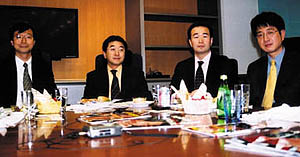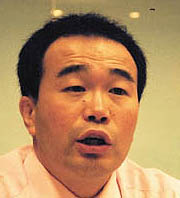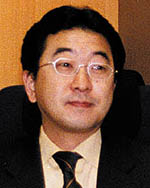Rountable: How to find Japan's Small-Cap Gems
Back to Contents of Issue: July 2002
|
|
|
 Roundtable participants (from left to right) Roundtable participants (from left to right)> Hirotaka Usama, president, Angel Japan Asset Management > Tsuyoshi Kuwabara, head of research, KBC Securities Japan > Naoki Suzuki, associate director of the Japan equity team, Schroder Investment Management (Japan) > Yasuaki Fujine, senior analyst and chief executive officer, Analyst Net Japan KBC's Tsuyoshi Kuwabara led a lively roundtable discussion on small and midsize companies in Japan. Kuwabara and three other veterans of the Japan investment scene talked about where the investment opportunities are and what sort of investment strategies companies take these days. Excerpts from the discussion follow. Kuwabara: Tell us about your investment philosophy. Usami: My investment style is strictly bottom-up. I am interested in supporting smaller companies as a way of rejuvenating Japan's economy. Suzuki: We do not have a specific small-/mid-cap fund or sector funds at Schroders Asset Management; rather the firm looks at companies on an individual basis. Traditional companies are changing their attitudes and are increasingly willing to put investors' interests first. Even traditional companies that have survived and are profitable will become concerned about shareholder equity. At Schroders we run mostly pension money, not investment trusts. Kuwabara: Fund managers who invest in small companies can visit them and contact the company directly. The role of a small-cap analyst is different from someone covering large-cap stocks. How can the small-cap analysts add value? Usami: When I was an analyst, I obtained various types of information, both negative and positive, directly from the companies, but I was often unable to disclose all the information I had. As a fund manager I can freely make use of all the information I receive. Many investors are short-term or short-sighted when it comes to investing in smaller companies. Many complain of earnings volatility in the short term but as a fund manager. I look at the long term, five years or so. So, I don't mind the volatility. All companies have good and bad points and you have to argue the pros and cons of each investment. The best way to get the best info is to go straight to the source. Analysts can filter out information for fund managers. Fund managers and analysts are similar in that they both need to figure out what to buy and why. As a fund manager, I receive 80-90 company reports a day. Analysts really need to separate data and facts from opinions. When they make a recommendation, you should always question it. Suzuki: For small-cap stocks, investors have a huge universe to choose from so it's tough for a sell-side firm to cover them all. I think coverage is difficult, but I generally look for someone who can point out sector trends and interesting companies. I want interesting, company-specific ideas and stories. A list of interesting companies, the industry insights, or a different approach are key for me. Kuwabara: I agree. At KBC we didn't want to set up a small-cap team because it's extremely difficult for an analyst to cover a wide variety of stocks across many sectors, which tends to happen at most firms if you are a small-cap analyst. Our approach is on a sector basis but with a focus on growing companies in the sector. I believe investors will welcome a real sector analyst who knows the large caps, of course, but can add value by focusing on growing companies that by their very nature are often small- and mid-cap in size. Fujine: Covering a wide range of companies is becoming more and more difficult as US style compliance spreads because it requires in-depth reports with no margin for error. A small-cap analyst should be a strategist; otherwise it's difficult to deliver value-added services to investors. This is perhaps an ad for my firm but I believe the small cap universe can be covered but only by a team. However it is quite labor intensive and difficult for an individual. At Analyst Net we have a matrix team approach in order to offer comprehensive research.  Kuwabara: What's your investment strategy?
Kuwabara: What's your investment strategy?Usami: I buy and hold stocks. That strategy has given me decent returns. I am particularly interested in growth companies. I can go long or short but normally am long only. Suzuki: I also use a buy and hold approach. We look at stocks on a fundamental basis, sometimes holding them for three or four years. As many of our clients are pension accounts, our risk levels are different. Kuwabara: How do you pick stocks? Usami: I use a spreadsheet that is 20-30 sheets long and I check many different ratios for each company on a quarterly basis. Suzuki: We do all sorts of screening but it is often harder to find the sell timing than to find a company to invest in. Fujine: For us management is the most important factor in making an investment decision. Particularly in small- and mid-sized companies, the president often decides everything. Kuwabara: I look at stocks on a sector basis, so for me the background of each company and trends are important. Kuwabara: Do you look at sectors or companies? Usami: No particular sector preference, but I do look at many small-/mid-cap firms. We often can find out a lot about the company by having a quick chat with the president or its business partners and clients. Suzuki: We don't weigh sectors according to market cap or anything like that; we look for interesting companies and look at the risk level of each company. We look at stocks and how they are influenced by both foreign and domestic factors. For example, the auto sector is currently being driven by foreign demand. We like the service sector and capital expenditure related sectors. The IT services sector is also looking interesting. We are seeing many traditional sectors undergoing restructuring. We remain very interested in the Internet and IT related sectors. Fujine: I don't look at sectors specifically but am very interested in trends in securities and the Internet sector as they both affect my underlying business. Kuwabara: What limitations to investing in small and mid caps do you see? Usami: I focus on growing companies. Every year, 200 new publicly listed companies emerge. If you do some preliminary screening and even if you only meet 10 percent, that's still 20 possibly interesting firms to invest in. Fund managers can dip their toes in by buying just 1 percent or less of a company, but it's more difficult for analysts as they really have to take a buy or sell view on the stock. Kuwabara: Mr Suzuki, pension funds mostly adopt a buy and hold approach. Due to index weightings you often need to hold large-cap stocks, but how do you add value by using a buy and hold approach for smaller companies? Suzuki: As you said, buy and hold is part of our mandate; we don't have too much choice. We do detailed fundamental analysis of each company with a three to four year horizon and evaluate the management. Our strategy is to wait for the difference to narrow between the market value and what we estimate to be the real value of where the stock should be. Kuwabara: At KBC we spend a lot of time thinking about how to provide liquidity in smaller and mid-cap growth companies through the use of equity linked and derivative products, in addition to providing a fundamental sector-driven focus on growth companies. Kuwabara: How does your investment process work?  Usami: Basically, I look at investment ideas on a company-by-company basis. I make my own projections, taking information from the company's prospectus and if it looks interesting, I begin to talk to management. I update my information on a quarterly, half yearly and full year base. All companies are different; however, if you analyze them by yourself you should be able to trust the figures. I talk to management on a regular basis and I'm not an analyst now, so management may give me a more honest view of what's really going on. I find management is quite open with me most of the time about both the positive and negative aspects of their company. I revise the portfolio every three months and during this time I also check analysts' reports to see any signals of a change in opinion. I use bottom-up analysis and don't hold any more than 4 percent in any one stock. Diversification really is the key, and I can increase the weighting in a good company if the price falls. If the company's stock price rises too much I trim the weighting.
Usami: Basically, I look at investment ideas on a company-by-company basis. I make my own projections, taking information from the company's prospectus and if it looks interesting, I begin to talk to management. I update my information on a quarterly, half yearly and full year base. All companies are different; however, if you analyze them by yourself you should be able to trust the figures. I talk to management on a regular basis and I'm not an analyst now, so management may give me a more honest view of what's really going on. I find management is quite open with me most of the time about both the positive and negative aspects of their company. I revise the portfolio every three months and during this time I also check analysts' reports to see any signals of a change in opinion. I use bottom-up analysis and don't hold any more than 4 percent in any one stock. Diversification really is the key, and I can increase the weighting in a good company if the price falls. If the company's stock price rises too much I trim the weighting.I visit my portfolio companies quite often, which gives me a good sense of what's really going on. Look at Uniqlo -- at first I felt confident about the management so I increased my stake and the stock price went up. Last year when profits fell, it was obviously no longer a growth company. It was generating profit but had moved out of the growth category so I reduced my stake. I like growing companies, but it's important not to fall in love with the company too much. Look at Hikari Tsushin and Softbank. In 1999, I bought small stakes in them and reduced my position as they went up. Overall they were still a small percentage of the diversified portfolio. A key area is information disclosure. I send a weekly report to my investors to keep them up to date. The market fluctuates and smaller companies can be volatile. If investors took a longer-term view their returns would be larger. I am setting up a new fund called Chance that will focus on fallen angels, many of the IPO stocks that have come back a long way. Many of them, fund managers just couldn't buy when they listed but most of them are cheap and there are some good companies in there as well. Suzuki: We believe sector analysis is key in trying to identify good companies and upcoming trends, you can't get this just from bottom-up analysis. We spend a lot of time discussing various issues with management. We really need to understand their vision or lack of it, how does that fit into what's happening around them and decide if that's a basis for us to look more closely at investing in the company. It's much harder to know when to sell the company and to be able to spot changes that may affect the firm negatively than it is to be able to find good companies.  Kuwabara: I also believe in a sector approach. I started off as a junior analyst in a non-IT sector and looked at individual companies so I got to know them quite well. I realized that many other factors influenced company stock prices and then started to focus on sector analysis. The key is to understand the trends and get the right balance as to the impact for each individual company. Management quality is key for me and I spend a lot of time on this. The company needs to be a going concern, to be interesting and, especially, have a constant reliable revenue stream. Analysts should be able to talk about other sectors and visit companies in other sectors that affect their own. We don't believe in a silo approach.
Kuwabara: I also believe in a sector approach. I started off as a junior analyst in a non-IT sector and looked at individual companies so I got to know them quite well. I realized that many other factors influenced company stock prices and then started to focus on sector analysis. The key is to understand the trends and get the right balance as to the impact for each individual company. Management quality is key for me and I spend a lot of time on this. The company needs to be a going concern, to be interesting and, especially, have a constant reliable revenue stream. Analysts should be able to talk about other sectors and visit companies in other sectors that affect their own. We don't believe in a silo approach.Fujine: Basically to find a good small- or mid-cap company, more than 50 percent of what's key is understanding the management, especially the president or key driver of the business. What kind of people are working in management, what does the business plan look like. Even if the business plan is still a bit rough, you can judge the company by the management's ability to implement the plan. One area of difficulty is how to get out of an investment. For analysts that's tough. If an analyst is the only one to put out a buy recommendation, he waits until another analyst also puts out a buy. Soon after that many other analysts will have buy recommendations out on the stock. That is the time for the first analyst to change his opinion. If a certain large investment bank comes out with a buy note, I know it's time to sell. Kuwabara: What sectors do you like now? Usami: The real estate sector looks interesting. There are some developers that are good at buying land cheaply and quickly customizing apartments to certain specifications to meet specific market demand. Suzuki: I don't weight sectors I just buy stocks. I like some of the foreign demand plays due to the weak yen, as some of them are benefiting from a pick up in overseas demand. If Koizumi's reforms actually make it through and begin to work, the service sector will clearly be a beneficiary. In capital expenditure, there will be a shift from investment in fixed assets to investment in IT and software services. We expect heavier restructuring in some of the more traditional sectors and as a result we expect to see the emergence of some new and interesting companies. Kuwabara: My focus is on IT, software and high-tech companies. Among these, I like companies with strong price competitiveness relative to the stagnant economic situation. I like the theme of broadband. The era of broadband has come, and it will be a hot topic for the time being. However, I believe the broadband companies themselves will not enjoy such high margins. Rather, investors should focus on companies that sell goods to the broadband companies, thus reducing their risk.  Fujine: If a company has both the demand and supply source, then they will do well. Look at Cyberagent and Rakuten. They track clients and have settlement functions. They need to create product and sell it. Cyberagent produces content and sells it as well as being a good media company. I don't like Yahoo Japan because it has no specific content and thus no loyalty from the Yahoo customer base.
Fujine: If a company has both the demand and supply source, then they will do well. Look at Cyberagent and Rakuten. They track clients and have settlement functions. They need to create product and sell it. Cyberagent produces content and sells it as well as being a good media company. I don't like Yahoo Japan because it has no specific content and thus no loyalty from the Yahoo customer base.Kuwabara: What do you think about short selling? Usami: I don't like it, as I am someone who wants to support Japanese companies. I understand there are many different market participants with different investment strategies but I just want to focus on growing companies. ii |
|
Note: The function "email this page" is currently not supported for this page.






